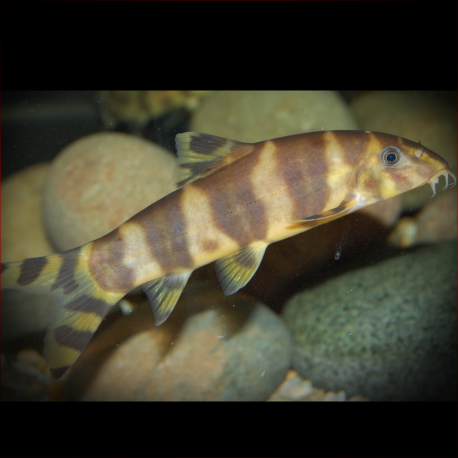More info
Datasheet
| Minimum Tank Size | 270 litres / 71.33 US gallons |
| Maximum Size | 15.0cm / 5.91inches |
| Temperature | 23°C / 73.40°F - 28°C / 82.40°F |
| Hardness | 1.01dgH / 18ppm - 8.01dgH / 143ppm |
| pH | 6.0-7.5 |
Behaviour
The Emperor Botia is not particularly aggressive but should not be housed with significantly smaller fish due to potential intimidation from its size and active behavior. Slow-moving, long-finned species like bettas, guppies, and certain cichlids should also be avoided to prevent fin nipping. Ideal tankmates include peaceful cyprinids that dwell in open water, as well as species from Barilius, Luciosoma, Balantiocheilos, Barbonymus, and compatible bottom-dwellers such as other Botia varieties. Botia spp. are social and should be kept in groups of at least 5 to 6 individuals to prevent aggression towards similarly-shaped fishes. These loaches exhibit various behavioral rituals, highlighting the importance of conspecific contact for their well-being.
Feeding and Diet
While primarily carnivorous, Emperor Botias also consume vegetative matter including soft-leaved aquatic plants. A balanced diet is crucial, consisting of quality dried foods, live or frozen bloodworms, Tubifex, brine shrimp, and fresh fruits and vegetables. Home-made gelatin-bound foods are highly recommended. These loaches may prey on aquatic snails but should not be relied upon as a solution for infestations. Once accustomed to aquarium conditions, they are bold eaters and readily feed on a diverse diet.
Reproduction & Dimorphism
Reproduction of the Emperor Botia in captivity is not well-documented, consistent with many botiid loaches. Commercial breeding with the use of hormones has been successful for other botiid species. Sexual dimorphism is observable, with mature females having a fuller body and rounded snout, while males possess an elongated snout and fleshier lips.
Habitat and Distribution
The Emperor Botia is native to the Tanintharyi River drainage in southern Myanmar. Its habitat likely resembles those of other Botia species in the genus. The area's remoteness and occasional conflict make it challenging for fish collectors to access, rendering the species relatively expensive when available. Named in honor of Kamphol Udomritthiruj, this species thrives in well-oxygenated, mature aquarium setups with stable water conditions.

